
ブックマークに登録されたオススメ天体
1. Objects in the Milky Way Galaxy
Objects in our own Milky Way Galaxy. Compared to the diameter of the Milky Way galactic disk (100,000 light-years), these objects are very close to our Solar System.
 Pleiades (M45, “Subaru” in Japanese)
Pleiades (M45, “Subaru” in Japanese)
Constellation: Taurus, Distance: 410 light-years
RA: 03 h 47 m 00 s, Dec: +24° 07′ 05″ (J2000)
Open star cluster with young, blue stars which were born about 6 million years ago. The Subaru Telescope was named after the Pleiades.
★ What does "Subaru" mean?
 Orion Nebula (M42)
Orion Nebula (M42)
Constellation: Orion, Distance 1500 light-years
RA: 05 h 35 m 17 s, Dec: -05° 23′ 28″ (J2000)
Stars are being born here. At the center of the nebula, Trapezium, a group of four bright stars, is clearly seen in infrared light. Hydrogen gas emits pink light (Hα line), and this pink color is typical in massive star-forming regions.
★ Infrared image taken with the Subaru Telescope
2. Individual objects outside of the Milky Way
Individual objects outside of our Milky Way Galaxy, but still relatively close to us at intergalactic scales. The Andromeda Galaxy (M31) and M101 are spiral galaxies, similar to our Milky Way Galaxy, with a galactic disk and spiral arms.
 Andromeda Galaxy (M31)
Andromeda Galaxy (M31)
Constellation: Andromeda, Distance: 2.3 million light-years
RA: 00 h 42 m 44 s, Dec: +41° 16′ 9″ (J2000)
The nearest spiral galaxy to our Milky Way Galaxy. M31 and the Milky Way are similar in shape and size. HSC captured almost all of M31 in one field of view. Massive star forming regions emit pink light like the Orion Nebula, and we can see many star-forming regions along the spiral arms.
★ Field of View of HSC
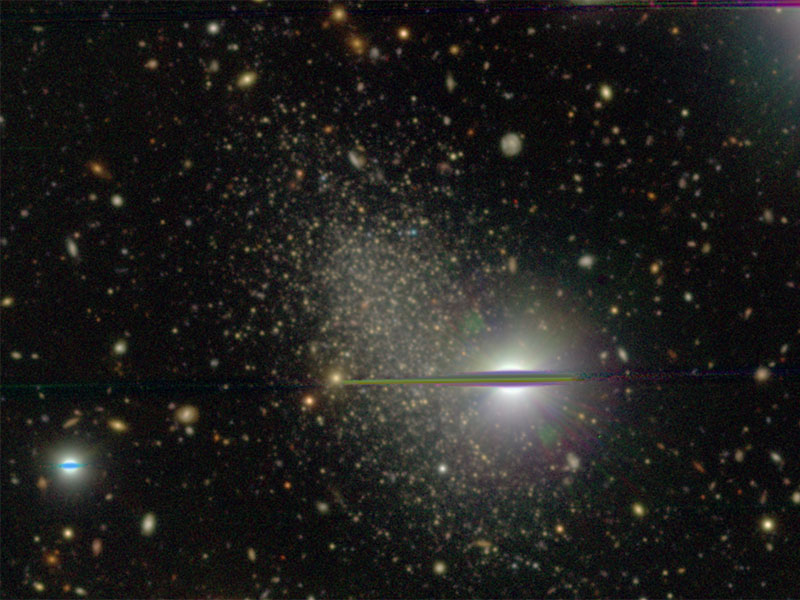 Dwarf Galaxy KKR25
Dwarf Galaxy KKR25
Constellation: Draco, Distance: 6.3 million light-years
RA: 16 h 13 m 48 s, Dec: +54° 22′ 16″ (J2000)
A small galaxy like Large and Small Magellanic Clouds is called a dwarf galaxy. In this image, a dwarf galaxy is seen as an extended dim object in the background behind a bright star in the Milky Way Galaxy. The straight lines on the bright star are spurious features.
 Spiral Galaxy M101
Spiral Galaxy M101
Constellation: Ursa Major, Distance: 19 million light-years
RA: 14 h 03 m 13 s, Dec: +54° 20′ 56″ (J2000)
M101 is also known as the "Pinwheel Galaxy." It is a face-on spiral galaxy and its spiral arms are seen. The bright knots are star clusters. In 2011, a supernova, SN 2011fe was spotted in this galaxy, and NAOJ’s MURIKABUSHI telescope at Ishigakijima Astronomical Observatory and other telescopes observed it.
3. Strong gravitational lenses
According to Einstein’s Theory of General Relativity, gravity curves the geometry of space-time. A massive object (gravity source) bends space-time due to its strong gravity. When a light source (like a star or a galaxy), a gravity source (like a black hole or another galaxy), and Earth lie in a straight line, the route of the light emitted from the light source is bent, and the light from multiple routes consequently converges and appears brighter than it normally would. We call this phenomenon the gravitational lensing effect because a gravity source behaves like an optical lens. Different positional relationships between the light source and the gravity source produce different effects like multiple images, arcs, or rings due to “strong gravitational lensing” when the gravitational lensing effect is powerful enough. The followings are objects where a strong gravitational lensing effect is seen.
★ A schematic image of the strong gravitational lensing effect on the NAOJ/ALMA website
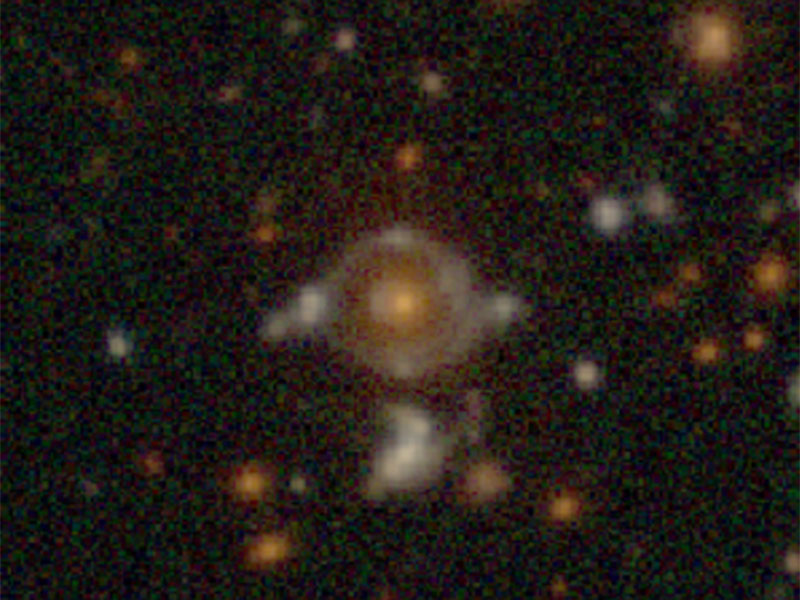 The Eye of Horus
The Eye of Horus
Constellation: Virgo, Distance: 9 billion & 10.5 billion light-years
RA: 14 h 24 m 49 s, Dec: -00° 53′ 22″ (J2000)
Field: GAMA15H
A rare gravitational lens object: two distinct background galaxies were lensed by the foreground galaxy. This object was named after the sacred eye of an ancient Egyptian god.
★ Discovery of the Eye of Horus
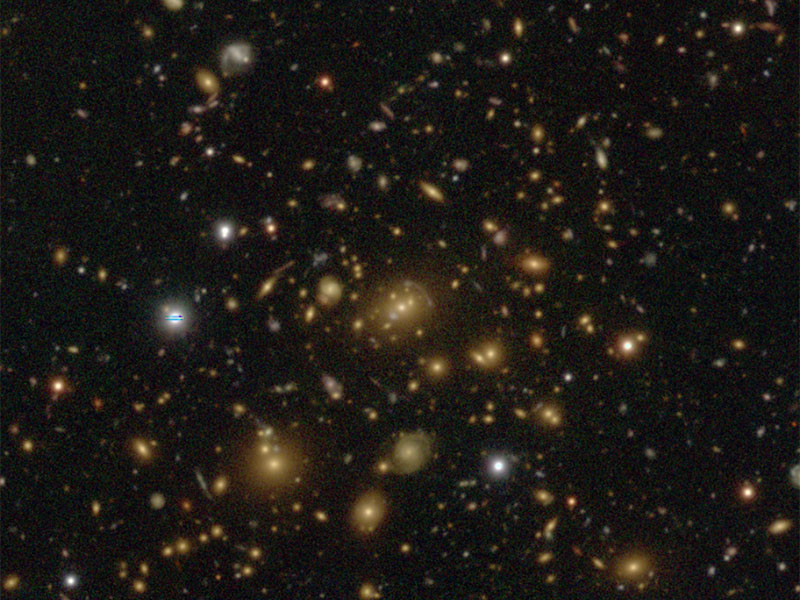 Gravitational Lens 1: SDSS J115214.19+003126.5
Gravitational Lens 1: SDSS J115214.19+003126.5
Constellation: Virgo
RA: 11 h 52 m 14.19 s, Dec: +00° 31′ 26.5″ (J2000)
Field: WIDE12H
Multiple arc structures are seen, which are characteristic of the strong gravitational lensing effect.
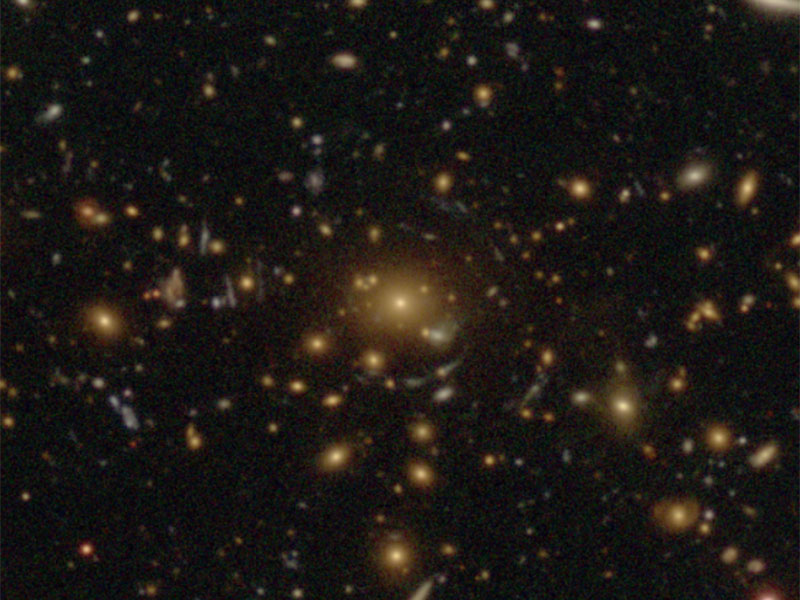 Gravitational Lens 2: NVSS J142016+005718
Gravitational Lens 2: NVSS J142016+005718
Constellation: Virgo
RA: 14h 20m 16.6s, Dec: +00° 57′ 19″ (J2000)
Field: GAMA15H
Multiple arc structures are seen, which are characteristic of the strong gravitational lensing effect.
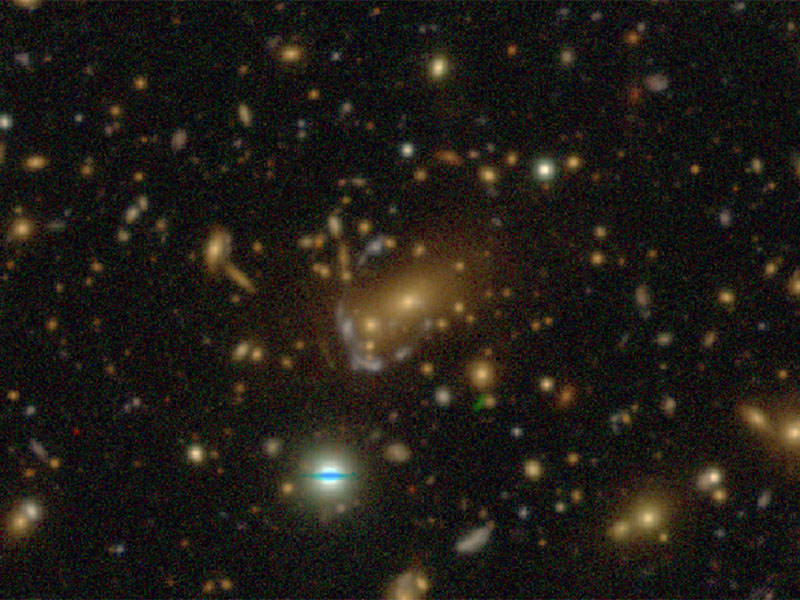 Gravitational Lens 3: 2SLAQ J144132.67-005358.3
Gravitational Lens 3: 2SLAQ J144132.67-005358.3
Constellation: Virgo
RA: 14h 41m 32.67s, Dec: -00° 53′ 58.3″ (J2000)
Field: GAMA15H
Multiple arc structures are seen, which are characteristic of the strong gravitational lensing effect.
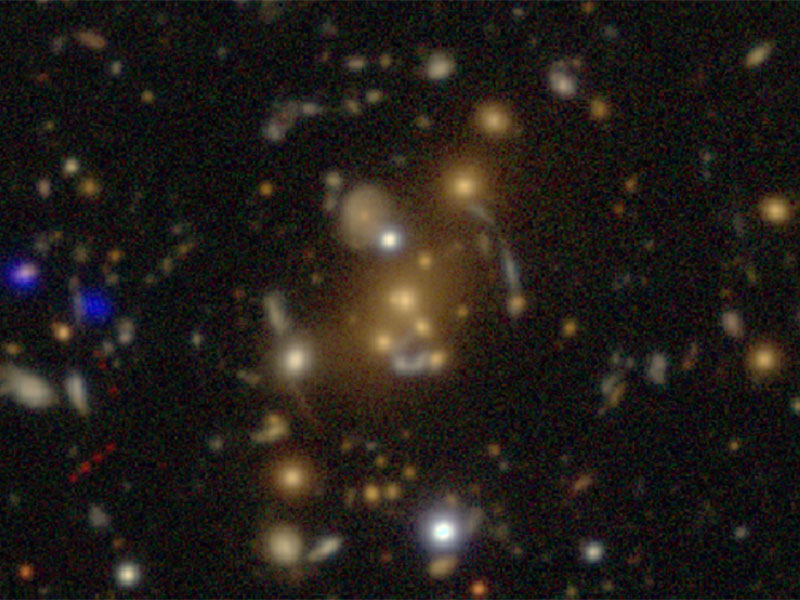 Gravitational Lens 4: PMN J2329-0121
Gravitational Lens 4: PMN J2329-0121
Constellation: Pisces
RA: 23h 29m 47.9s, Dec: -01° 20′ 49″ (J2000)
Field: DEEP2-3
Multiple arc structures are seen, which are characteristic of the strong gravitational lensing effect.
4. Interacting galaxies
Galaxies change their shapes by colliding and merging with each other over billions of years. Gravitational interactions like collisions and mergers between galaxies are common, and are observed frequently. In the HSC images, many interacting galaxies are found. When two galaxies interact through mutual gravitation, they affect each other’s shapes, and a straight “tail” or an “arc” structure is created.
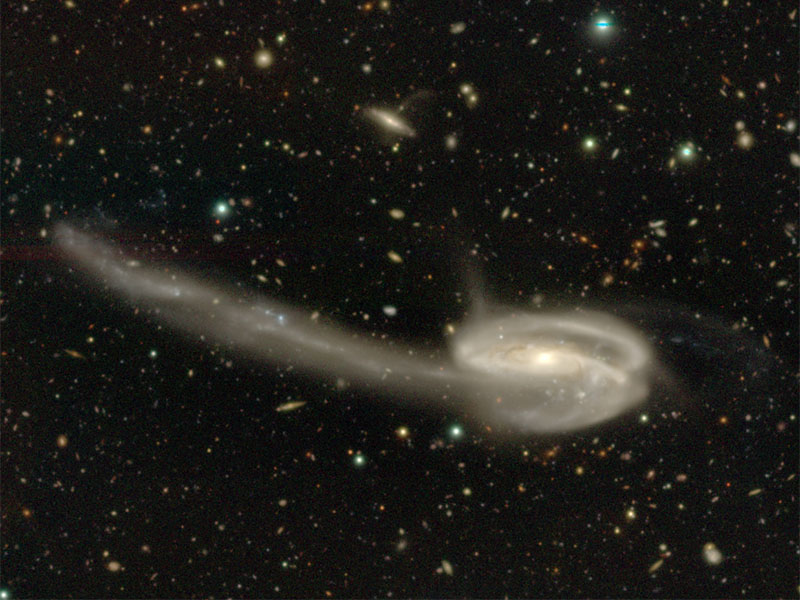 Tadpole Galaxy (UGC 10214)
Tadpole Galaxy (UGC 10214)
Constellation: Draco, Distance: 400 million light-years
RA: 16 h 06 m 03.9 s, Dec: +55° 25′ 32″ (J2000)
Field: ELAIS-N1
The long tail of stars in this barred spiral galaxy is thought to have been made by gravitational interactions due to a galactic encounter. When a small galaxy passed by this galaxy, stars, gas, and dust were pulled along creating a structure about 280,000 light-years long that resembles the tail of a tadpole.
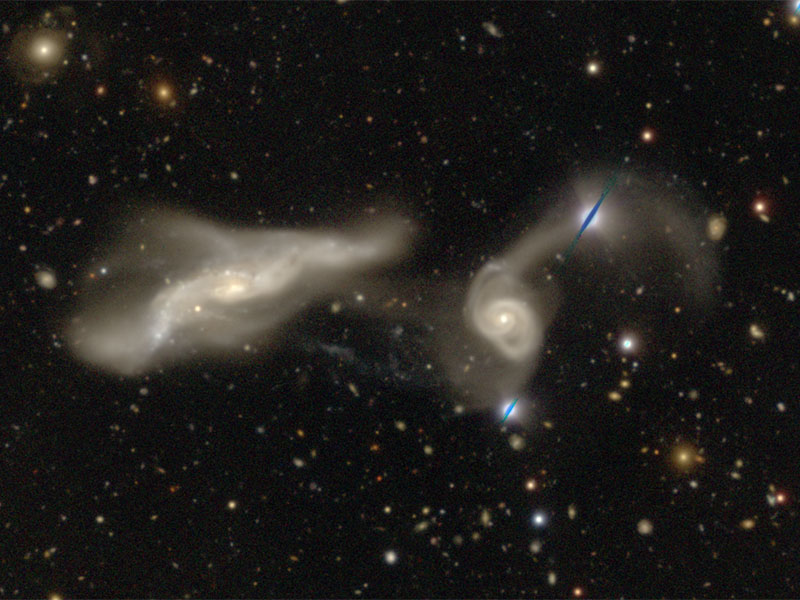 Interacting Galaxies 1: UGC 12589 & 2MASX J23250382+0001068
Interacting Galaxies 1: UGC 12589 & 2MASX J23250382+0001068
Constellation: Pisces
RA: 23 h 25 m 01.7 s, Dec: +00° 00′ 01.9″(UGC 12589)
Field: DEEP2-3
Two spiral galaxies are attracting one another through their mutual gravity and changing their shapes.
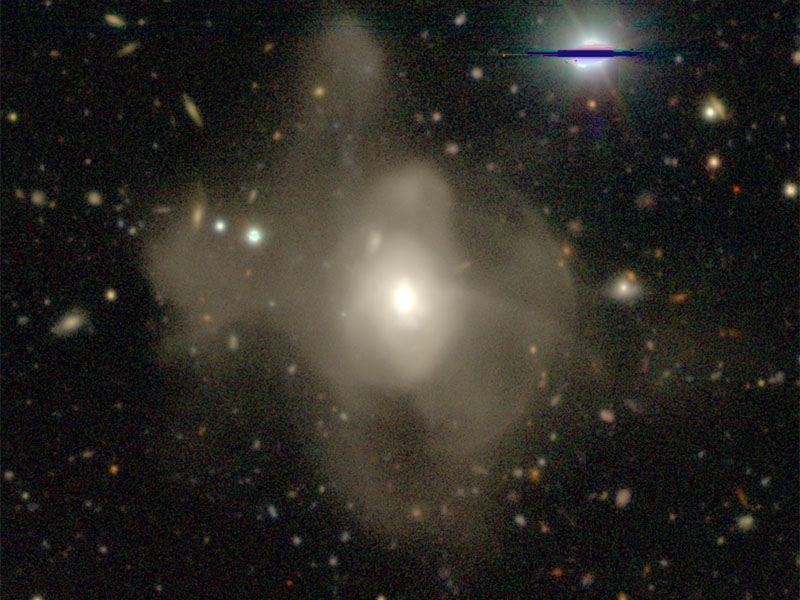 Interacting Galaxies 2: 2MASX J16270254+4328340
Interacting Galaxies 2: 2MASX J16270254+4328340
Constellation: Hercules
RA: 16 h 27 m 02.5 s, Dec: +43° 28′ 34.1″ (J2000)
Field: HECTOMAP
This shape is thought to have formed after galaxies merged. Many arched structures made by gravitational interaction are seen around the central core of the galaxy.
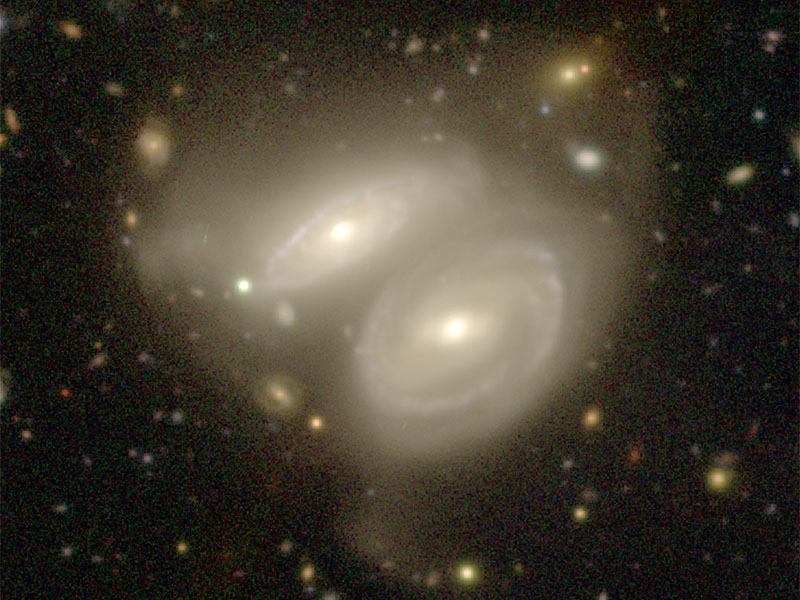 Interacting Galaxies 3: LEDA 2535615 & LEDA 2535506
Interacting Galaxies 3: LEDA 2535615 & LEDA 2535506
Constellation: Draco
RA: 16 h 14 m 53.4 s, Dec: +56° 24′ 08.8″(LEDA 2535615)
Field: ELAIS-N1
Two spiral galaxies are attracting one another through their mutual gravity. A halo surrounds the two galaxies.
 Interacting Galaxies 4: NGC 7667
Interacting Galaxies 4: NGC 7667
Constellation: Pisces
RA: 23 h 24 m 22.8 s, Dec: -00° 06′ 30.2″ (J2000)
Field: DEEP2-3
This galaxy looks like a shrimp, a DEEP-fried shrimp in the DEEP2-3 field.
 Interacting Galaxies 5: UGC 9327 & FIRST J143043.0+001510
Interacting Galaxies 5: UGC 9327 & FIRST J143043.0+001510
Constellation: Virgo
RA: 14 h 30 m 43.0 s, Dec: +00° 15′ 10.7″ (J2000)
Field: GAMA15H
This galaxy looks like a jellyfish.
5. Galaxy clusters
A galaxy cluster is a group of many galaxies that are bound together by gravity. It is a relatively large-scale group of hundreds or thousands of galaxies gathered together in an area about 10 million light-years in diameter. A relatively small-scale group of dozons of galaxies gathered together in an area about 1.5 million light-years in diameter is called a galaxy group. Our Milky Way Galaxy is a member of a galaxy group called the Local Group, along with the Andromeda Galaxy and Large and Small Magellanic Clouds.
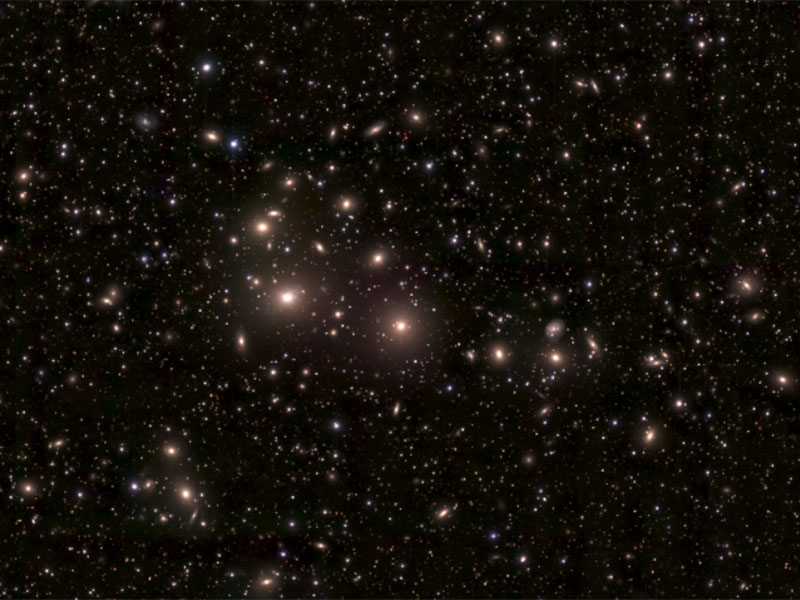 Perseus Cluster
Perseus Cluster
Constellation: Perseus, Distance: 230 million light-years
RA: 03 h 19 m 47.2 s, Dec: +41° 30′ 47″ (J2000)
About 500 galaxies gathered together. The galaxy NGC 1275 hosting a massive black hole is located at the center of the cluster and emits strong radio waves.
6. Objects in the early Universe
Our Universe is thought to have begun 13.8 billion years ago. Objects in the early Universe appear far away from us. For example, an object existing 0.8 billion years after the beginning of the Universe, that is an object from 13.0 billion years ago, is located 13.0 billion light-years away from us. These distant objects are very faint, and a large telescope such as the Subaru Telescope with high light gathering power is essential to observe them.
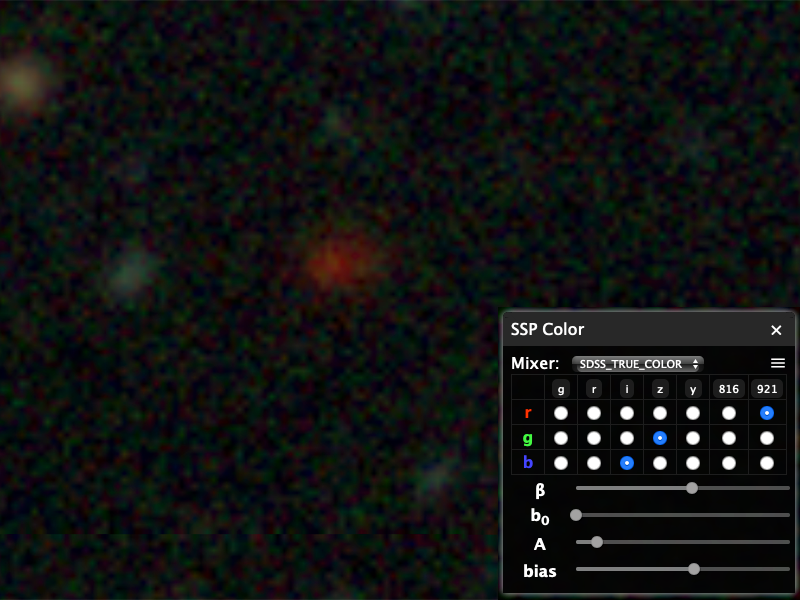 Himiko
Himiko
Constellation: Cetus, Distance: 13.0 billion light-years
RA: 02 h 17 m 57.6 s, Dec: -5° 8′ 44.9″ (J2000)
Field: SXDS
A big body of hot gas (Lyman-Alpha blob) that existed when the Universe was 0.8 billion years old. It was discovered with the Subaru Telescope. Himiko is named after a legendary, mysterious ancient Japanese queen because this object is strikingly bright in the ancient Universe.
★ Discovery of Himiko with the Subaru Telescope
★ Observations with ALMA and other telescopes
Note) It is difficult to see Himiko with the HSC-viewer’s default color settings. Try openning the "SSP Color" Window
and assigning red to NB921, green to the z-band, and blue to the i-band.
With these settings, the light from Himiko in a very narrow wavelength band (NB921) can be seen in red.